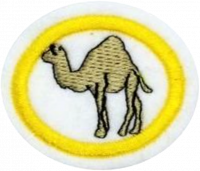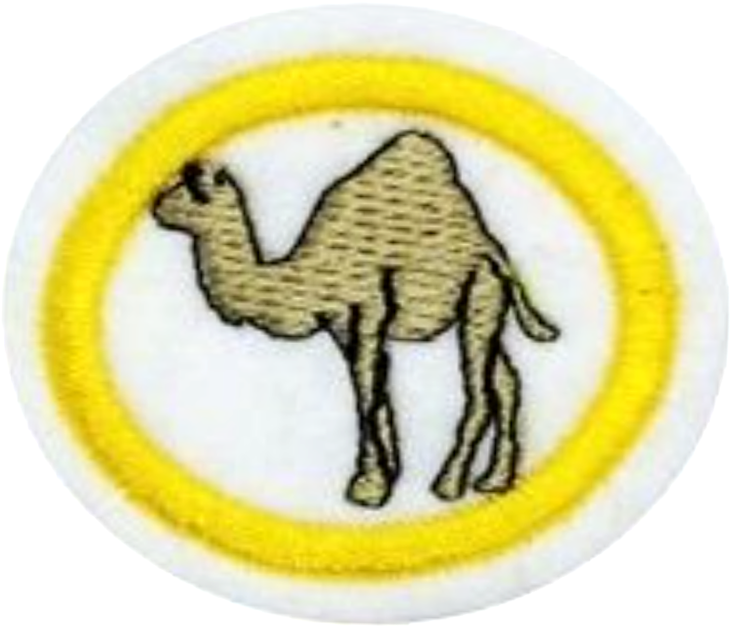Especialidades JA/Camellos/Respuestas
1
2
2a
2b
2c
2d
3
3a
3b
3c
3d
4
The domesticated alpaca and llama are not endangered. They have been exported to many countries in the world and in the US and Canada at least, supply exceeds demand.
5
6
There are about 59 total verses that reference camel(s), camel hair and a camel saddle in the Bible. Here are all of them grouped chronologically:
Job owned 3,000 camels in Job 1:3 but he lost them in Job 1:17 before the Lord gave him 6,000 camels by Job 42:12.
Genesis 12:16 Abram/Abraham owned camels and in Genesis 24 sent them with his servant to Nahor where Rebekah was. After Rebekah waters the camels she and others rode the camels.
Jacob acquired camels Genesis 30:43 and used them for riding and as pack animals Genesis 31:17 and Genesis 32:7
In Genesis 31:34 Rachel hid an idol in her camel saddle, while sitting in the tent.
In Genesis 32:15 Jacob gifted 30 female camels and their young to his brother Esau.
In Genesis 37:24-26 we see that the caravan of Ishmaelites coming from Gilead had camels loaded with spices, balm and myrrh, and and were heading to Egypt. Joseph is sold by his brothers to the traders with the camels.
Camels in Egypt and the Exodus
In Exodus 9:2-4 we learn the Egyptians had camels along with horses, donkeys, cattle, sheep and goats (the Israelites might also have had camels, as the text says they had livestock too, but that God would not harm the Israelite's animals.
God in Leviticus 11:4 and Deuteronomy 14:7 declares that camels are unclean and should not be eaten.
Judges
It was impossible to count the Midianites or their camels in Judges 6:5 when they invaded the land to ravage it. Also in Judges 7:12 "The Midianites, the Amalekites and all the other eastern peoples had settled in the valley, thick as locusts. Their camels could no more be counted than the sand on the seashore."
In Judges 8 we learn that some Midianite camels wore ornaments and chains on their necks (which could be gold from the context). Gideon and others took these off the camels necks.
United Kingdom
In 1 Samuel 15:3 God commanded that the Amalekites be totally destroyed. "Do not spare them; put to death men and women, children and infants, cattle and sheep, camels and donkeys."
According to 1 Chronicles 5:21 In the days of Saul "they (the Israelites) seized the livestock of the Hagrites—fifty thousand camels, two hundred fifty thousand sheep and two thousand donkeys. They also took one hundred thousand people captive."
David's practice was to take plunder, including camels according to 1 Samuel 27:9
Four hundred young Amalekite men escaped David's band by riding off on camels in 1 Samuel 30:17-18
1 Chronicles 12:40 says that "neighbors from as far away as Issachar, Zebulun and Naphtali came bringing food on donkeys, camels, mules and oxen" while David's army was growing.
1 Chronicles 27:30 "Obil the Ishmaelite was in charge of the camels" for King David.
The Queen of Sheba (modern Ethiopia) used camels as pack animals in 1 Kings 10:2 and the parallel account in 2 Chronicles 9:1 when she came to see King Solomon.
Divided Kingdom, Exile and Return
2 Kings 8:9 says that "Hazael went to meet Elisha, taking with him as a gift forty camel-loads of all the finest wares of Damascus. He went in and stood before him, and said, “Your son Ben-Hadad king of Aram has sent me to ask, ‘Will I recover from this illness?’”"
King Asa's army when fighting the Cushites in 2 Chronicles 14:15 "also attacked the camps of the herders and carried off droves of sheep and goats and camels."
Isaiah 21:7 mentions riders on camels. Isaiah 30:5-7 says "A prophecy concerning the animals of the Negev: Through a land of hardship and distress, of lions and lionesses, of adders and darting snakes, the envoys carry their riches on donkeys’ backs, their treasures on the humps of camels, to that unprofitable nation, to Egypt, whose help is utterly useless. Therefore I call her Rahab the Do-Nothing."
Isaiah 60:6 mentions "Herds of camels will cover your land, young camels of Midian and Ephah." and Isaiah 66:20 proposes people will come on camels to Jerusalem to worship.
Jeremiah 2:22-24 compares Israel to a sexually excited "swift she-camel running here and there"! Now that's a graphic metaphor.
Jeremiah writes in Jeremiah 49 that the Kedar and the kingdoms of Hazor, which Nebuchadnezzar king of Babylon attacked will lose their camels.
Ezra's band of returning exiles had "736 horses, 245 mules, 435 camels and 6,720 donkeys." Ezra 2:66-67 and Nehemiah 7:69
Ezekiel 25:5 predicts that "I will turn Rabbah into a pasture for camels and Ammon into a resting place for sheep. Then you will know that I am the Lord."
Zechariah 14:15 says that a plague will strike the livestock, including camels, of the enemies of the Lord.
New Testament
In Mark 1:6 and Matthew 3:4 John the Baptist's clothes were made of camel’s hair, and he had a leather belt around his waist.
In Matthew 19:24, Mark 10:25 and Luke 18:25 Jesus says that "Again I tell you, it is easier for a camel to go through the eye of a needle than for someone who is rich to enter the kingdom of God.” (see Question 6 above)
Matthew 23:24 Jesus says "You blind guides! You strain out a gnat but swallow a camel."



